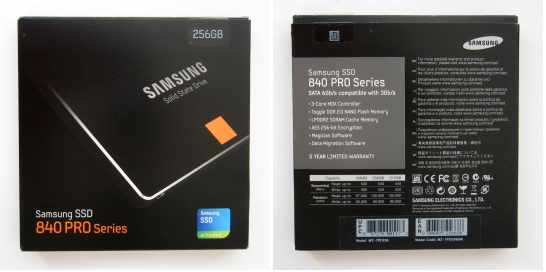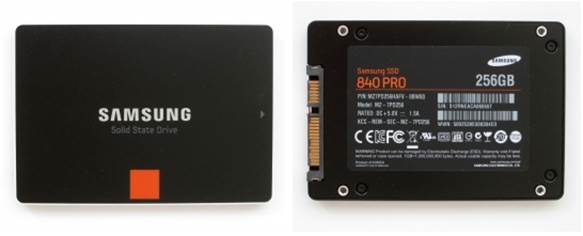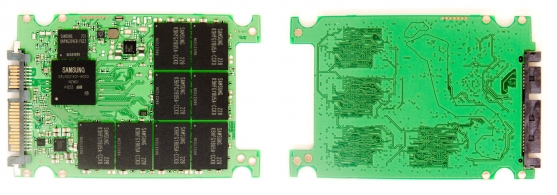Samsung offers very interesting SSDs. Some
boast outstanding performance, others - are designed with inexpensive TLC NAND
and comes with a very attractive price. And our tests proved all of this: we
are ready to discuss what we saw when we got our hand on a Samsung 840 Pro 256
GB and Samsung 840 250 GB drives.
When the SSD manufacturers want to
emphasize their strengths, they often talk about how much technical resources
they put into their products. An SSD generally has three basic components:
flash memory, controller and software. Not all companies engaged into SSD
business today create these components on their own. In contrast, the majority
of consumer-class SSDs are assembled with components manufactured by third
parties as if from Lego bricks.
So, if we want to rank the SSD
manufacturers according to how original their products are, we have to start
from SandForce platform. Most of SandForce-based SSDs are merely clones of the
reference design, using flash memory from Toshiba or Intel and reference
firmware from LSI.
The next layer consists of companies that
do not develop and do not manufacture semiconductor components but try to
provide original products by optimizing software and customizing firmware. For
example, Corsair and Plextor (Lite-On) assembled SSDs from the common types of
flash memory and widespread controllers but release products that have no
analogs.
Of course, it's even better if there is
flash memory that is manufactured. Intel, SanDisk and Crucial (Micron) always
have their own chips in their SSDs, enabling them to adopt a more flexible
pricing policy.
Even so, to have one’s own SSD controller
is the dream of any SSD manufacturer. Developing one depends on some technical
resources, but the end result can be superior to competing solutions because
any user's requirements can be accounted for in this case. OCZ is an example of
a company that has its own SSD controller, but it does not produce
semiconductor components.
So that's not OCZ but Samsung is in the
leading position of our rating. Samsung can build SSDs include 100% Samsung
components: an initial controller with original firmware and flash memory
manufactured by Samsung. Although this does not guarantee success, Samsung does
not have everything needed to provide high-performance, reliable and
inexpensive SSDs that many advanced users dream of.
That's why it's so hopefully when we tested
the Samsung's SSDs. The previous 830 series had very attractive specifications
and was actually among the best for a long time. After that, the company
improved its controllers and started making faster and cheaper flash memory,
which resulted in the new and highly promising 840 series. It comes with the
basic version and the professional version, and we have the opportunity to test
both of them.
A closer look at the Samsung 840 Pro 256 GB
As a major manufacturer of NAND flash
memory, Samsung can easily introduce cutting-edge memory types into its
serially produced SSDs. The new 840 series is a good example because both basic
and advanced versions boast 21nm flash with Toggle Mode 2.0 interface whose
bandwidth has been increased up to 400 Mbit/s. However, that is not the key
feature of the new Samsung products. Their main advantage is the fourth generation
MDX controller. Samsung has been significantly improved its controller with
each new SSD series, so the chip used in the 840 series will hopefully become a
fastest consumer-class SSD controller available.
It works based on three 300MHz ARM
Cortex-R4 cores. Besides a faster version of the ARM architecture, the
controller provides a 40% advantage in clock rate in comparison with its
predecessor from Samsung 830 series. The previous MCX controller could hardly
be blamed for low performance and the new MDX has better computing resource,
which is important in terms of Samsung's declared priorities. When developing
new products, the company focused on making them faster at processing
random-address data. This type of load is typical of a lot of everyday tasks
and today's SSDs are not as good at handling it as they are at sequential
reading and writing.
To process a lot of unrelated I/O requests
the SSD controller has to translate LBA addresses used by the operating system
into the actual position of data in the flash memory. This is where today's
SSDs have improved. The speed of processing random-address data blocks is much
lower than the SATA 3 bandwidth, so Samsung focuses on strengthening it. This
is indicated by the specific characteristics of the new SSDs, we can compare
the specs of the old Samsung 830.
Manufacturer promises a 25% increase in
random read speed whereas random writing may be up to 2.5 times as fast as
before. That's impressive results, we must admit. Featuring faster memory and
no artificial bottlenecks, Samsung Pro 840 is expected to provide the highest
performance, so we will start with it.
Our Samsung Pro 840 sample is packed in a
small and stylishly designed cardboard box painted mostly black. The storage
capacity is indicated by a sticker on the front of the box. Key features and
specifications of the product are listed on the back.

Samsung
840 Pro
SSD is fixed in a plastic wrap along with
its accessories which do not include a 2.5->3.5-inch system case adapter.
There are only a few documents, a couple of stickers and a CD with electronic
manual and software.
The SSD itself looks gorgeous. Made out of
aluminum alloy, it is black-anodized and has shiny fascias on its face side. A
manufacturer logo and terracotta square are painted on the top of the case, so
you can easily identify the 840 lines. At the bottom of the case there is a
dark gray sticker with the full product name, part number, serial number and
barcodes.

Product
Images
The case is 7 mm thick and Samsung doesn’t
offer any frames or faceplates to increase its thickness to the more
conventional 9.5 mm.
The PCB is placed only on one side. All the
chips we can see on it are produced by Samsung.

Product's
circuit board
There are three types of chips in the SSD.
First, it is the above-described Samsung MDX controller. Second, there is a
low-voltage LPDDR2-1066 SDRAM chip for 512 MB of cache memory. Both 256GB and
512GB models are equipped with that much cache whereas the 128GB Samsung 840
Pro comes with 256 MB of cache. And third, we can see eight flash memory chips
with Toggle Mode 2.0 interface. Each of them has a capacity of 32 GB and has
four 64-gigabit NAND MLC components produced based on Samsung's 21nm.
Therefore, the MDX controller uses 4-way interleaving on each of its eight
channels in the 256GB SSD.